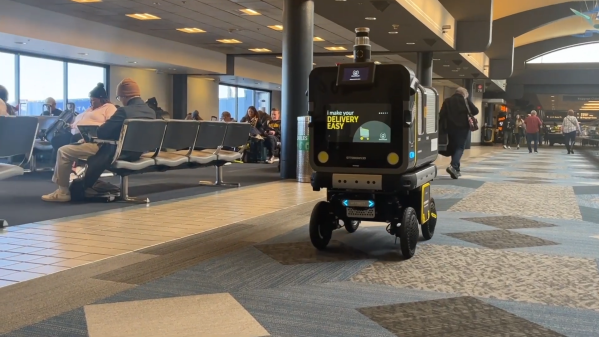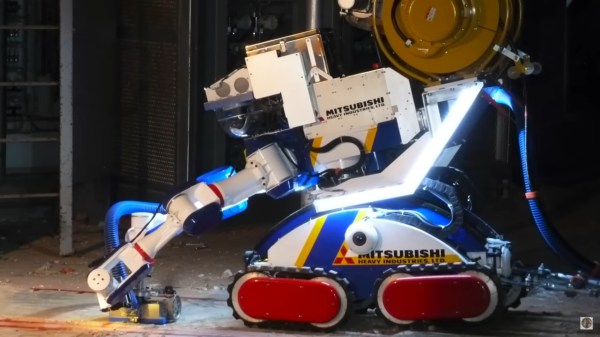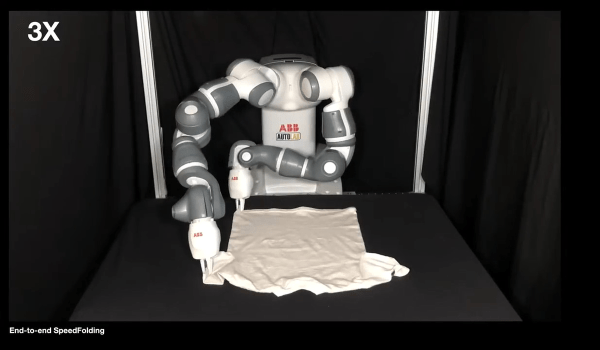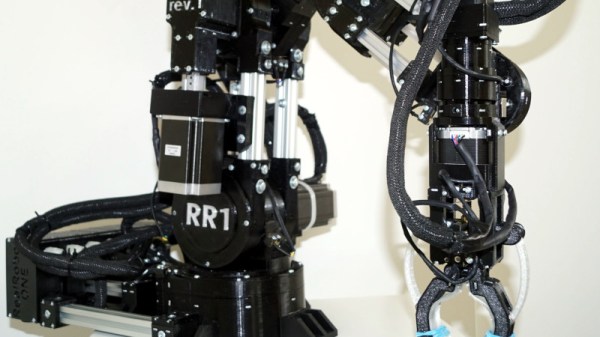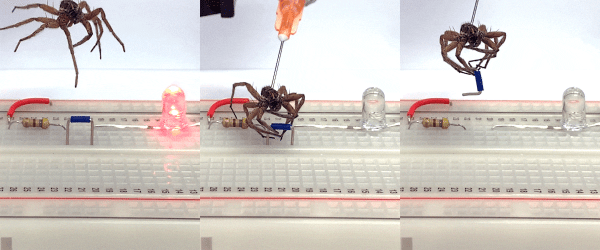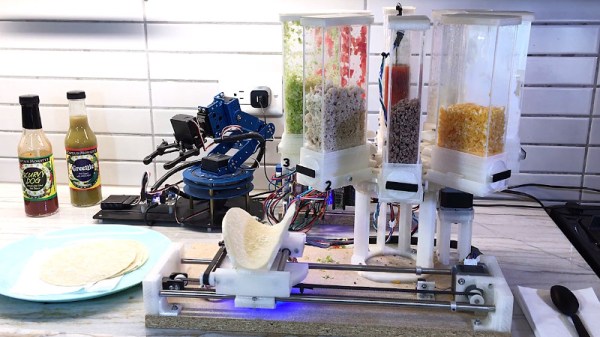Within the world of medical science fiction they are found everywhere: tiny robots that can zip through blood vessels and intestines, where they can deliver medication, diagnose medical conditions and even directly provide treatment. Although much of this is still firmly in the realm of science-fiction, researchers at Stanford published work last year on an origami-based type of robots, controlled using an external magnetic field. Details can be found in the Nature Communications paper. Continue reading “Tiny Robots That Bring Targeted Drug Delivery And Treatment A Little Bit Closer”
robotics187 Articles
Your Next Airport Meal May Be Delivered By Robot
Robot delivery has long been touted as a game-changing technology of the future. However, it still hasn’t cracked the big time. Drones still aren’t airdropping packages into our gutters by accident, nor are our pizzas brought to us via self-driving cars.
That’s not to say that able minds aren’t working on the problem. In one case, a group of engineers are working ton a robot that will handle the crucial duty of delivering food to hungry flyers at the airport.
Continue reading “Your Next Airport Meal May Be Delivered By Robot”
The Robots Of Fukushima: Going Where No Human Has Gone Before (And Lived)
The idea of sending robots into conditions that humans would not survive is a very old concept. Robots don’t heed oxygen, food, or any other myriad of human requirements. They can also be treated as disposable, and they can also be radiation hardened, and they can physically fit into small spaces. And if you just happen to be the owner of a nuclear power plant that’s had multiple meltdowns, you need robots. A lot of them. And [Asianometry] has provided an excellent synopsis of the Robots of Fukushima in the video below the break.
Starting with robots developed for the Three Mile Island incident and then Chernobyl, [Asianometry] goes into the technology and even the politics behind getting robots on the scene, and the crossover between robots destined for space and war, and those destined for cleaning up after a meltdown.
The video goes further into the challenges of putting a robot into a high radiation environment. Also interesting is the state of readiness, or rather the lack thereof, that prompted further domestic innovation.
Obviously, cleaning up a melted down reactor requires highly specialized robots. What’s more, robots that worked on one reactor didn’t work on others, creating the need for yet more custom built machines. The video discusses each, and even touches on future robots that will be needed to fully decommission the Fukushima facility.
For another look at some of the early robots put to work, check out the post “The Fukushima Robot Diaries” which we published over a decade ago.
Continue reading “The Robots Of Fukushima: Going Where No Human Has Gone Before (And Lived)”
Robots Are Folding Laundry, But They Suck At It
Robots are used in all sorts of industries on a wide variety of tasks. Typically, it’s because they’re far faster, more accurate, and more capable than we are. Expert humans could not compete with the consistent, speedy output of a robotic welder on an automotive production line, nor could they as delicately coat the chocolate on the back of a KitKat.
However, there are some tasks in which humans still have the edge. Those include driving, witty repartee, and yes, folding laundry. That’s not to say the robots aren’t trying, though, so let’s take a look at the state of the art.
Continue reading “Robots Are Folding Laundry, But They Suck At It”
Real Robot One Is… Real
Most of the robot arms we see are cool but little more than toys. Usually, they use RC servos to do motion and that’s great for making some basic motion, but if you want something more industrial and capable, check out [Pavel’s] RR1 — Real Robot One. The beefy arm has six degrees of freedom powered by stepper motors and custom planetary gearboxes. Each joint has an encoder for precise position feedback. The first prototype is already working, as you can see in the video below. Version two is forthcoming.
When you see the thing in action, you can immediately tell it isn’t a toy. There are four NEMA23 steppers and three smaller NEMA17 motors. While there are 3D printed parts, you can see a lot of metal in the build, also. You can see a video of the arm lifting up a 1 kilogram barbell and picking up a refreshing soft drink.
Dead Spider Becomes Robot Gripper: It’s Necrobotics!
Robot arms and grippers do important work every hour of every day. They’re used in production lines around the world, toiling virtually ceaselessly outside of their designated maintenance windows.
They’re typically built out of steel, and powered by brawny hydraulic systems. However, some scientists have gone for a smaller scale approach that may horrify the squeamish. They’ve figured out how to turn a dead spider into a useful robotic gripper.
The name of this new Frankensteinian field? Why, it’s necrobotics, of course!
Continue reading “Dead Spider Becomes Robot Gripper: It’s Necrobotics!”
An Impressively Functional Tacobot
We’re big fans of useless machines here at Hackaday, there’s something undeniably entertaining about watching a gadget flail about dramatically without actually making any progress towards a defined goal. But what happens when one of these meme machines ends up working too well? We think that’s just what we might be witnessing here with the Tacobot from [Vije Miller].
On the surface, building an elaborate robotic contraption to (slowly) produce tacos is patently ridiculous. Doubly so when you tack on the need to give it voice commands like it’s some kind of one-dish version of the Star Trek food replicator. The whole thing sounds like the setup for a joke, an assumption that’s only reinforced after watching the dramatized video at the break. But in the end, we still can’t get over how well the thing appears to work.
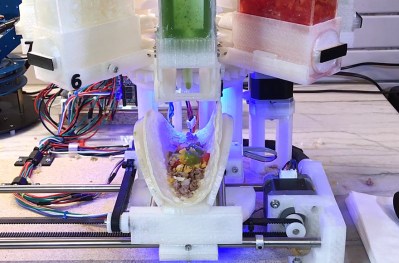 After [Vije] gives it a list of ingredients to dispense, a robotic arm drops a tortilla on a fantastically articulated rotating platform that can not only spin and move in two dimensions, but can form the soft shell into the appropriate taco configuration. The empty shell is then brought under a rotating dispenser that doles out (or at least attempts to) the requested ingredients such as beef, onions, cheese, and lettuce. With a final flourish, it squirts out a few pumps of the selected sauce, and then presents the completed taco to the user.
After [Vije] gives it a list of ingredients to dispense, a robotic arm drops a tortilla on a fantastically articulated rotating platform that can not only spin and move in two dimensions, but can form the soft shell into the appropriate taco configuration. The empty shell is then brought under a rotating dispenser that doles out (or at least attempts to) the requested ingredients such as beef, onions, cheese, and lettuce. With a final flourish, it squirts out a few pumps of the selected sauce, and then presents the completed taco to the user.
The only failing appears to be the machine’s ability to dispense some of the ingredients. The ground beef seems to drop into place without issue, but it visibly struggles with the wetter foodstuffs such as the tomatoes and onions. All we know is that if a robot handed us a taco with that little lettuce on it, we’d have a problem. On the project page [Vije] acknowledges the issue, and says that a redesigned dispenser could help alleviate some of the problem.
The issue immediately brought to mind the fascinating series of posts dedicated to handling bulk material penned by our very own [Anne Ogborn]. While the application here might be a bit tongue-in-cheek, it’s still a perfect example of the interesting phenomena that you run into when trying to meter out different types of materials.


